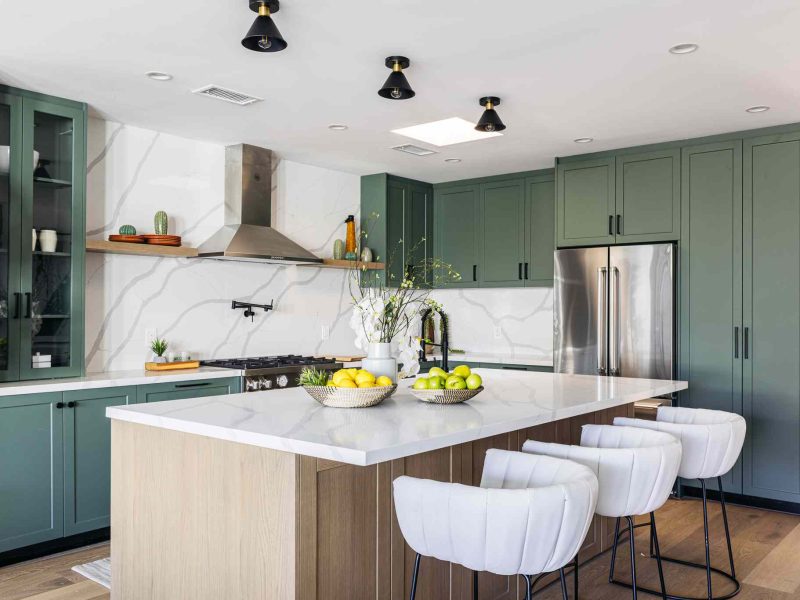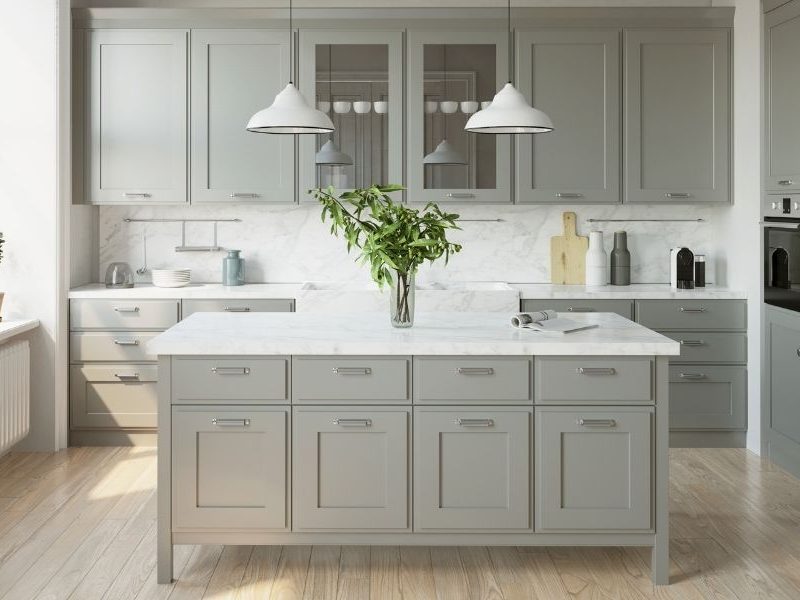Staining kitchen cabinets is an easy and cost-effective way to update your kitchen. It can instantly transform your space from outdated to modern and chic. It can also bring personality to your cabinets and make them look custom-made. With the right materials and a bit of patience, you can give your kitchen a brand-new look with a beautiful stain job. This guide will help you learn how to stain kitchen cabinets like a pro.
Identifying the Type of Kitchen Cabinet
Staining kitchen cabinets is an excellent way to give your kitchen an updated look, but before you begin, it’s important to identify the type of cabinet you have. Knowing the type of cabinet you have will determine the kind of finish you can use, the products you’ll need to use, and any special instructions that might be required. The two most common types of kitchen cabinets are laminate and wood.
Laminate cabinets have a plastic coating that is applied over a particleboard and can be identified by its smooth, uniform finish. Wood cabinets are made from solid wood and can be identified by its natural grain and texture. If the cabinets are painted, you will need to strip off the paint before you begin staining.
Once you know the type of cabinet you have, you can choose the right finish and products for the job. For example, if you have laminate cabinets, you’ll need to use a special primer and sealer to ensure the stain will adhere properly. With wood cabinets, you’ll also need to select the right type of stain and sealer to achieve the look you want.
By understanding the type of kitchen cabinet you have and using the right products, you can give your kitchen an updated, fresh look with a beautiful, lasting finish.
Prepping the Cabinets for Staining
Staining kitchen cabinets is an effective way to add a new layer of protection, as well as a new look, to your kitchen. Before you get started, you need to make sure the cabinets are ready for staining. This includes prepping the surface, cleaning the cabinets, and sanding them down.
To prep the cabinets, make sure the surface is free from dirt, grease, and other debris. This can be done by wiping them down with a damp cloth and a mild detergent. Once your cabinets are clean, you will need to sand them. This is important as it will help the stain adhere and last longer. Use fine-grit sandpaper and sand in the direction of the wood grain.
Once you’ve sanded the cabinets, you need to clean them again. This will ensure there is no dust or dirt on the surface. After cleaning, you can apply a wood conditioner. This will help the stain adhere to the cabinets better and provide a more even finish.
Staining kitchen cabinets can be a fun project, but it’s important to make sure the cabinets are properly prepped before you start. This includes cleaning the cabinets, sanding them down, and applying a wood conditioner. Following these steps will ensure that your cabinets will look great and last for years to come.
Choosing the Right Stain
When it comes to choosing the right stain for your kitchen cabinets, you have a lot of options. Depending on the type of wood you have and the look you’re going for, you can choose a light, dark, or medium stain. To help you find the right stain, here are a few tips to consider.
First, consider the type of wood you have. Different types of wood absorb stains differently, so it’s important to pick the stain that works best for the type of wood you have. For example, Maple and Oak absorb stains quickly, while Cherry and Mahogany absorb stains more slowly.
Second, consider the look you’re going for. Do you want a light, natural look? Or are you aiming for a darker, more dramatic look? Depending on the look you’re going for, you’ll need to choose a stain that best complements the overall aesthetic of your kitchen.
Finally, consider your budget. Staining kitchen cabinets can be expensive, especially if you go for a darker stain. To save money, consider purchasing stain samples first to see if you like the color before committing to the full purchase.
By following these tips, you can choose the right stain for your kitchen cabinets. With the right stain, you can transform your kitchen cabinets and create a beautiful space that is both functional and aesthetically pleasing.
Applying the Stain
Staining kitchen cabinets is an effective way to completely transform the look of your kitchen. Before beginning the staining process, it is important to understand the basics. Knowing which type of stain to use, how to prepare the surface, and the best application techniques are essential to achieving the desired result.
When it comes to staining kitchen cabinets, the key is to use an oil-based stain. This type of stain provides superior coverage, adhesion, and durability. Furthermore, it is easy to apply and will last for years. Be sure to test the stain on a hidden area before applying it to the entire cabinet to ensure you are happy with the color.
Preparing the surface is also important for a successful staining job. Sand the cabinets with medium-grit sandpaper and then wipe away any dust with a damp cloth. Once the surface is prepared, you can begin to apply the stain. With a brush or cloth, apply a thin, even layer of stain to the entire cabinet. Allow the stain to dry, and then apply a second coat if needed.
When it comes to staining kitchen cabinets, it is important to be patient and take your time. By following the steps outlined above, you can easily create the look you desire. With a little bit of effort, you can transform your kitchen into a beautiful and inviting space that you and your family can enjoy for years to come.

Finishing the Stain of Kitchen Cabinets
Staining kitchen cabinets is a great way to add character to your kitchen and give it a unique, personalized look. Applying the stain to cabinets can be a difficult and time-consuming job, but it is worth the effort to get a beautiful, professional finish. Preparing the surface is the key to success and will ensure an even, long-lasting finish. Cleaning and sanding the surface, applying the stain, and sealing the surface are the steps that should be followed for a successful staining project.
When staining kitchen cabinets, start by thoroughly cleaning the surface with a mild cleaner and a soft cloth. Once the surface is free of any dirt and debris, use fine-grit sandpaper to scuff up the surface. This will enable the stain to penetrate the wood, creating a deeper, richer color. Next, apply the stain in the direction of the wood grain, using a lint-free cloth. Take your time and work in small sections to ensure an even application and a smooth finish. Once the desired color is achieved, seal the stain with a polyurethane sealer. This will protect the surface from wear and tear, and keep the color looking vibrant and beautiful.
Staining kitchen cabinets is a great way to improve the look and feel of your kitchen. With patience and the right techniques, you can achieve a beautiful, professional finish. With the right preparation and care, you can make sure your staining project lasts for years to come.
Maintaining the Kitchen Cabinets
Staining kitchen cabinets is a great way to update the look of your kitchen and give it a fresh new feel. However, it can be a daunting and time-consuming process. To ensure that the stain on your kitchen cabinets stays looking great and lasts for years to come, it is important to properly maintain them. Regular cleaning and occasional recoating with a fresh layer of stain can help to keep your cabinets looking like new. With the right cleaning products, you can easily keep your kitchen cabinets clean and in excellent condition.
First, you will need to choose the right cleaning products for your cabinets. When selecting a cleaner, look for one that is specifically designed for wood surfaces. A mild dish soap and water solution can also be used to clean kitchen cabinets. Avoid using harsh cleaners or abrasive cleaning tools, as these can damage your cabinets.
Once you have selected the right cleaning products, use a soft cloth to wipe down your cabinets with the cleaning solution. Make sure to thoroughly clean any hard-to-reach areas. After cleaning, you can use a damp cloth to wipe away any excess cleaner. When you are done, dry your cabinets with a soft cloth to prevent water spots.
Conclusion
Staining kitchen cabinets can be a great way to update the look of your kitchen without spending a lot of money. With careful preparation and proper application, you can achieve a beautiful finish that will last for years to come. Be sure to use the right tools and materials, and always follow the manufacturer’s instructions when staining your cabinets. With the right products and techniques, you can create a stunning transformation in your kitchen.


